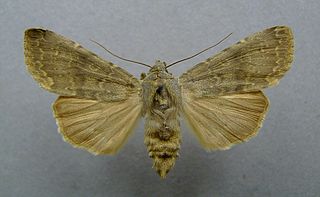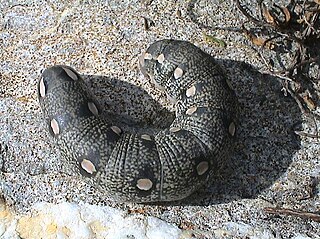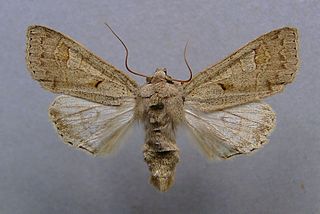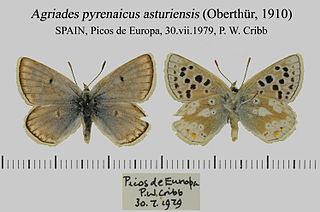
The willowherb hawkmoth is a moth in the family Sphingidae. The species was first described by Peter Simon Pallas in 1772.

Conistra rubiginosa, the black-spot chestnut, is a moth of the family Noctuidae. The species was first described by Giovanni Antonio Scopoli in his 1763 Entomologia Carniolica. It is found in Europe.

Thysanoplusia daubei is a moth of the family Noctuidae. It is found in North and East Africa, Southern Europe, Arabia, Turkey, Southern Iran to the Himalayas, India, Indochina, China, Japan and Taiwan.

Globia algae, the rush wainscot, is a moth of the family Noctuidae. The species was first described by Eugenius Johann Christoph Esper in 1789. It is found in central and southern Europe, Turkey, Armenia, northern Caucasus, south-west Siberia.
Shargacucullia barthae is a moth of the family Noctuidae first described by Boursin in 1933. It is found in Turkey, Iraq, Iran and the Near East.
Shargacucullia strigicosta is a moth of the family Noctuidae. The species was first described by Boursin in 1940. It is found in Iraq and the Sinai in Egypt. Recently it has also been recorded from Israel and some areas of Turkey, Azerbaijan and Iran.
Calocucullia celsiae is a moth of the family Noctuidae. The species was first described by Gottlieb August Wilhelm Herrich-Schäffer in 1850. It is found from the Balkans to Turkey, northern Iraq, Armenia, Iran, Israel, Jordan and Lebanon.
Metalopha gloriosa is a moth of the family Noctuidae first described by Otto Staudinger in 1887. It is found from western Turkey to eastern Taurus Mountains, Iraq, Anatolia, Israel, Jordan, Lebanon and Syria.

Rhyacia lucipeta, the southern rustic, is a moth of the family Noctuidae. It is found in Morocco, Algeria, the Pyrenees, the mountains of central Europe, Italy, the Balkans, Turkey, the Caucasus, Transcaucasia and Iraq.

Hyles vespertilio is a moth of the family Sphingidae.

Ammoconia caecimacula is a moth belonging to the family Noctuidae. It is found in most of Europe, excluding regions such as southern Spain, Great Britain, Ireland and northern Fennoscandia. Additionally, it can be found in Anatolia, western Turkestan and across the Palaearctic to Siberia. In the east the species is represented by subspecies transcaucasica and sibirica.

Ammoconia senex is a moth of the family Noctuidae. It is found in the European part of the Mediterranean Region and an isolated population near the Middle Rhine. It is also found in Turkey, the Caucasus, Iraq and Iran.

Phyllonorycter esperella is a moth of the family Gracillariidae. It is found from Sweden to the Pyrenees, Italy and Greece and from Great Britain to Ukraine.

Anatis ocellata, commonly known as the eyed ladybug, is a species of ladybug in the family Coccinellidae. It has black spots on a red background, with each spot surrounded by a yellowish halo. In one color variation, a specimen found in Scotland was reported having the spots fused to form longitudinal lines. Sometimes can also be found variation where black spots are absent.
Monochroa suffusella, the notch wing neb, is a moth of the family Gelechiidae. It is found from Fennoscandia to the Pyrenees and Alps and from Ireland to Romania. In the east, the range extends to Japan. The habitat consists of bogs, fens, swamps and salt-marshes.

Syngrapha devergens is a moth of the family Noctuidae. It is found in the Alps, the Tian Shan Mountains and the Altai Mountains
Nothris lemniscellus is a moth of the family Gelechiidae. It was described by Philipp Christoph Zeller in 1839. It is found from Fennoscandia to the Pyrenees, Italy and Albania, and from France to Ukraine.

Panchrysia aurea is a moth of the family Noctuidae. It is found in southern Europe and western and central Asia. The range extends from Portugal, east to Tian Shan, the Altai and the north-western Himalayas. In central Europe, it is found in the southern Alps, lower Austria and the mountains on the Balkan Peninsula.

Plusidia cheiranthi is a moth of the family Noctuidae. It is found in Southern and Eastern Europe, in Turkey, Siberia and eastwards to the Pacific Ocean.

Agriades pyrenaicus, the Gavarnie blue, is a Palearctic butterfly of the family Lycaenidae. It is found in the Asturias mountains of north-western Spain, the Pyrenees, the southern Balkan Peninsula, Turkey, the Caucasus and Armenia. The habitat consists of alpine grassy rocky meadows where it is found at altitudes ranging from 1,500 to 2,200 meters.













